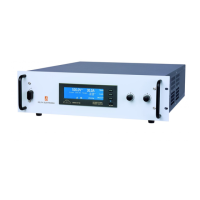Ethernet & Sequencer Programming SM15K
23 / 44 DELTA ELEKTRONIKA B.V. rev. Aug. 2019
Same principle is used for the current calibration.
Default settings for the offsets are 0, and default settings for the gains are 1. The resolution of both settings
and readings are 4 digits.
Note: Both gain and offset changes influence the actual output parameter. After changing offset, check if
the gain has to change. And visa versa. To get a very accurate result, redo the calibration a few times.
To save the calibration settings to the non-volatile memory, refer to section 5.1
Since the programming and monitoring is proportional to the output voltage / current, scaling should be
taken into account.
Example:
Situation: SM500-CP-90 with INT MOD ANA is configured for analog programming with 0-5V range.
Programming voltage is 5.001V, Vprg gain is 1.003 and the output voltage results in 499.75V.
New Vprg gain is:
Programmed voltage / actual voltage * old gain = 500.100 / 499.705 * 1.003 = 1.0038.
Note: the programmed voltage is not 5.001V, but the expected output voltage of the unit itself.
Note: Range offset: About 1/33 of the maximum voltage / current,
Range gain: 0.9 to 1.1.
Calibrate Gain Current Programming
To calibrate the analog programming gain of the current setting:
Syntax: CALIbrate:INTerface:GAIn<sp><slot>,IPRG,<NR2><term>
To read the calibration setting:
Syntax: CALIbrate:INTerface:GAIn<sp><slot>,IPRG?<term>
Calibrate Offset Current Programming
To calibrate the analog programming offset of the current setting:
Syntax: CALIbrate:INTerface:OFFset<sp><slot>,IPRG,<NR2><term>
To read the calibration setting:
Syntax: CALIbrate:INTerface:OFFset<sp><slot>,IPRG?<term>
